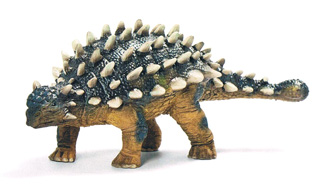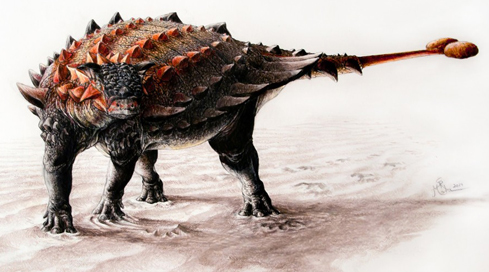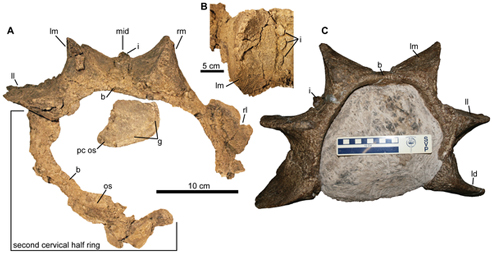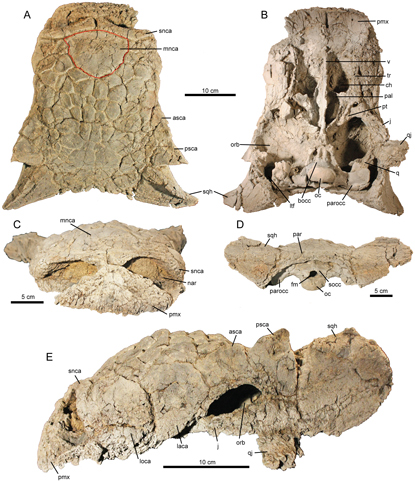Ziapelta sanjuanensis From New Mexico but Closely Related to Canadian Ankylosaurs
For some strange reason, the ankylosaurs don’t seem to be held in quite the same awe as the horned dinosaurs by most members of the public. We at Everything Dinosaur have our own theory about this. The horned dinosaurs are much easier for the lay person to recognise. There is the spectacular spiked frill of Styracosaurus, the peculiar nasal boss of Pachyrhinosaurus, a dinosaur genus which came to greater prominence with the “Walking with Dinosaurs in 3-D” movie. Then there is of course, the most famous horned dinosaur of all – Triceratops (three horned face).
The Ankylosauridae
Members of the Ankylosauridae tend to have the same basic body plan. They have broad rumps, bony clubs on the end of their tails and of course, all that body armour. Model makers often find it difficult to distinguish different armoured dinosaurs. For example, the Saichania replica made by Schleich, to the uninitiated, resembles Ankylosaurus.
The Saichania Model made by Schleich
Picture credit: Everything Dinosaur
When it comes to films and television documentaries, the ankylosaurs are rarely given star billing. So today, in our own small way, we are going to champion the Late Cretaceous armoured dinosaurs by discussing the newest member of their family – Ziapelta, from the San Juan Basin of north-western New Mexico. The fossils of Ziapelta consist of elements of the skull and incomplete neck rings of spiky bone and fragments of the famous, scaly Ankylosauria body armour (osteoderms).
Discovered in 2011
The material was discovered in 2011 by Robert Sullivan, subsequently excavated by Dr Sullivan and colleagues and then stored at the New Mexico Museum of Natural History and Science. Once extracted from its silt and sandstone matrix, the scientists had enough fossil evidence to assign these fossils to a new genera. A thorough exploration of the surrounding area produced no further post-cranial material. It seems the head and neck of this armoured dinosaur were separated from the rest of the body prior to burial. How this came about, one can only speculate.
Ziapelta sanjuanensis
The fossils were collected from the De-na-zin Member of the Kirtland Formation which as been dated to around 74 to 72 million years ago. At perhaps as much as six metres long, the herbivorous Ziapelta would have been a very formidable adversary for even the largest tyrannosaurid.
An Illustration of Ziapelta (Z. sanjuanensis)
Picture credit: Sydney Mohr
To the lay person, the spiky-looking Ziapelta might just look like any other Ankylosauridae, so let’s explain why the skull and neck material have allowed scientists to erect a new genus of armoured dinosaur. Firstly, elements of the skull have been found, the skull morphology (shape) and composition can be very helpful when looking to identify an animal new to science, dinosaurs included. Co-author of the scientific paper, which is published in the on line academic journal PLOS One, Victoria Arbour commented:
“The horns on the back of the skull are thick and curve downwards and the snout has a mixture of flat and bumpy scales – an unusual feature for an ankylosaurid.”
Closely Related to Canadian Ankylosaurids
Dr Arbour (University of Alberta) is a renowned expert on all things ankylosaur, she was invited to examine the fossils along with PhD student Mike Burns (University of Alberta). The scientists concluded that unlike the armoured dinosaur Nodocephalosaurus kirtlandensis, which is also known from the San Juan Basin and is believed to be related to Asian genera of the Ankylosauridae, Saichania for example, Ziapelta was more closely related to the ankylosaurids of Canada.
The Formidable Spiky Cervical Rings of Ziapelta
Picture credit: PLOS One
Dr Arbour stated:
“Bob Sullivan, who discovered the specimen, showed us pictures and we were really excited by both its familiarity and its distinctiveness. We were pretty sure right away we were dealing with a new species that was closely related to the ankylosaurs we find in Alberta.”
Unusual Features
Ziapelta has another unusual feature that distinguishes it from other ankylosaurids, a feature that we at Everything Dinosaur find quite endearing considering the size and fearsome nature of these reptiles. The layout of the scales that make up the top of the skull are often very distinctive. In the case of Ziapelta, it has a large triangular-shaped scale on the tip of its snout, in contrast to many other ankylosaurids which have a six-sided scale on their snouts
Views of the Skull Fossil of Ziapelta (Z. sanjuanensis)
Picture credit: PLOS One
The photograph above shows various views of the holotype skull material, A – dorsal view (view from the top), B = ventral view (viewed from underneath), C = anterior view (view from the front), D = occipital view (viewed from the rear) and finally E – left lateral view (view of the left side of the skull). In photograph A, we have highlighted in red the outline of that large triangular scale on the snout (referred to as mnca – median nasal caputegulum to use the formal scientific term).
Dr Arbour put it very succinctly stating:
“There’s also a distinctive large triangular scale on the snout, where many other ankylosaurids have a hexagonal scale.”
Specialising in Studying Ankylosaurs
The University of Alberta scientist has specialised in studying ankylosaurs, especially those specimens which are known from the Late Cretaceous of North America. Back in 2013, Everything Dinosaur reported on Dr Arbour’s research into the Ankylosauridae which was helping to redefine this family of dinosaurs.
To read more about this research: When is a Euoplocephalus a Euoplocephalus?
Ankylosaurid fossils make up a small, but significant proportion of the Dinosauria fossil assemblage of southern Alberta, but to date, no ankylosaurid material has been found in the Horseshoe Canyon Formation (lower parts of this formation, the Strathmore and the Drumheller Members) of Alberta. These rocks are roughly the same age as the strata in which the fossils of Ziapelta were found. This New Mexico armoured dinosaur is helping palaeontologists to plug a gap in the record of ankylosaurid fossils known from North America.
Dr Arbour explained:
“The rocks in New Mexico fill in this gap in time, and that’s where Ziapelta occurs. Could Ziapelta have also lived in Alberta, in the gap where we haven’t found any ankylosaur fossils yet? It is possible, but in recent years there has also been increasing evidence that the dinosaurs from the southern part of North America – New Mexico, Texas and Utah, for example, are distinct from their northern neighbours in Alberta.”
There is a lot of evidence to support the idea of “dinosaur provinciality” in North America. It seems that although the overall mix of dinosaurs was about the same in the regions, the actual genera that made up the dinosaur populations differed markedly. How or why these distinct faunas came about remains something of a mystery. The discovery of Ziapelta may help to add more pieces to the picture as palaeontologists strive to solve this puzzle.










This is one cool dinosaur. the prehistoric tank of its time. Who was its predator?
It is difficult to assign a specific genus to the fossil material, isolated teeth indicate the presence of large tyrannosaurids. The Tyrannosaur Bistahieversor is known from New Mexico but from slightly older strata perhaps with some potential species overlap. Other Tyrannosaur fossil material from the area has been assigned to Daspletosaurus. In addition, isolated teeth of Dromaeosaurs have been found.
Having seen the answer in your Facebook asking why ankylosaurs arr lesser known than ceratopsians,I think there are two main reasons.First of all,the best known member of this group is Triceratops,which is one of the most famous dinosaurs all time.Then.there’s been a big number of discoveries of ceratopsians recently,for example,Kosmoceratops,Diabloceratops,Nasutoceratops…
People,when resding the news about these discoveries,the word ‘ceratopsian’ is always mentioned,hence part of its fame.I like ankylosaurs as well,they’re ijteresting creatures.
Thanks for your input, much appreciated.
I am not a specialist in herbivorous dinosaurs, but i have studied 9 years on predatory dinos. It is my opinion that these dinosaurs(ankylosaurs) had no enemy. however, the younglings possibly did not develop their armor fast, so yes, i have to agree with the tyrannosaurs being there enemy, but only to the young.